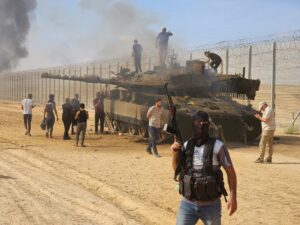 Marwan Kabalan : On October 7, the Palestinian armed resistance group Hamas launched an attack that took Israel by surprise. Its fighters overran Israeli military installations and settlements, which led to the death of some 1,400 Israelis.
Marwan Kabalan : On October 7, the Palestinian armed resistance group Hamas launched an attack that took Israel by surprise. Its fighters overran Israeli military installations and settlements, which led to the death of some 1,400 Israelis.
Israel responded by launching another war on Gaza, imposing a complete blockade and relentlessly bombing civilian buildings and infrastructure. More than 6,500 Palestinians have been killed by Israeli bombardment, including more than 2,000 children.
The Hamas attack has not only changed the path of the Palestine-Israel conflict, but also the dynamics of the whole Middle East. It has left the US strategy of de-escalation in the region in shambles, put Arab governments and Iran in a difficult position and opened the door for greater Chinese and Russian involvement.
US strategy undermined
Over the past three years, the Biden administration has been trying to limit its involvement in the Middle East and focus on China, as part of its “pivot to Asia”.
To do that, the US hoped to “cool off” tensions in the region by facilitating the normalisation of relations between Saudi Arabia and Israel and de-escalating with Iran. It also hoped to challenge Chinese influence in the region and boost India’s by establishing an economic corridor that would link India, the Middle East and Europe.
The proposed project had two parts: an eastern corridor, which would connect India to the Arab Gulf states, and a northern corridor, which would link the Gulf states to Europe via Jordan and Israel. It was supposed to be the US response to China’s Belt and Road Initiative.
The Hamas attack has put an abrupt end to these plans. First, it has effectively frozen the normalisation process between Israel and Saudi Arabia, thwarting the conclusion of a regional security arrangement.
Second, the attacks also compelled the US to reverse its policy of diminished military presence in the region by ordering the biggest military buildup since the war on ISIL. The Pentagon deployed one aircraft carrier in the Eastern Mediterranean, while another one has been sent to the Gulf. Together, they provide more than 100 aircraft with attack capabilities, as well as cruisers, destroyers and submarines equipped with Tomahawk missiles. Washington says that this buildup is to prevent a third party from opening another front against Israel.
Third, US efforts to de-escalate tensions with Iran have also come to an end. Just a month ago, the two countries reached an agreement on a prisoner swap and the release of $6bn worth of frozen Iranian assets. It was hoped the deal would encourage Iran to restrain its militias in Syria and Iraq from launching further attacks against US forces.
Developments of the past week demonstrate that this arrangement has not held. Pro-Iran armed groups in Syria and Iraq have launched attacks on US military bases, wounding a number of US personnel. The US officials have also claimed that US forces in the northern Red Sea have intercepted drones and missiles launched by the Houthis in Yemen.
All of this means the US is at risk of being dragged into another regional war in the Middle East.
Arab and Iranian dilemmas
The Hamas attack and the Israeli war on Gaza have also put regional governments in difficult positions. On one hand, the US has been pressuring its Arab allies, a number of whom had normalised relations with Israel, to condemn Hamas. Only the United Arab Emirates and Bahrain issued such statements.
On the other hand, Israel’s indiscriminate killing of Palestinian civilians has angered the Arab public and also put pressure on Arab governments to take action in solidarity with the Palestinians. There are already signs that the weight of public opinion is pushing Arab leaders to go against US wishes.
The massacre in al-Ahli Baptist Hospital on October 17 prompted sharp condemnations from Arab states, including from the UAE and Bahrain. At the Cairo Peace Summit on October 21, King Abdullah II of Jordan, whose country signed a peace treaty with Israel in 1994, delivered his strongest speech so far in condemnation of Israeli policies.
During a UNSC session on October 24 to debate the situation in Gaza the foreign ministers of Egypt, Jordan and Saudi Arabia – all close US allies – strongly condemned Israel and called for an immediate ceasefire. A day later, the UAE, along with China and Russia vetoed a US resolution that did not call for a cessation of fighting.
For the time being, pro-US Arab governments are resorting to strong rhetoric to quell public anger. But if Israel continues its deadly assault on Gaza, words will not be enough – they will have to take action by reversing normalisation with Israel, which could anger the US.
A lack of action by Arab leaders to protect Palestinians could lead to a new wave of regional instability. The Arab public is already angered by failed economic policies and the indiscriminate killing of Palestinians will just further infuriate it. Once again, US support for Israeli atrocities in Gaza is undermining the Arab regimes it supports.
Iran also finds itself in a difficult position, albeit for different reasons. The Iranian leadership praised Hamas’s October 7 attack while denying any involvement in it.
Tehran is threading carefully trying not to be dragged into a direct confrontation with Israel or its ally, the US, while at the same time supporting Hamas.
Israel has declared that the goal of its war on Gaza is to dismantle the Palestinian resistance group – ie, carry out regime change in the strip. This means Tehran could lose an important ally in the region.
It, thus, faces a difficult choice between standing idle and watching Hamas being weakened or eliminated by Israel or encouraging its Lebanon-based Hezbollah to enter the fray and put pressure on Israel in the north, which could have grave consequences for its ally.
Both Israel and the US warned that Hezbollah would face dire consequences if it attacked Israel. Having secured full US support, Israel might use this opportunity to attack the Lebanese group. This would certainly destabilise Lebanon, which is not in the interest of Iran.
Russian and Chinese calculus
The involvement of the US in another conflict in the Middle East and the weakening of its alliances with Arab states would be a welcome development for Moscow and Beijing.
Both countries benefited from Washington’s bloody interventions in the Greater Middle East over the past two decades. The US-led “war on terror” hurt US standing in the region, encouraging positive perceptions of Russia and China among Muslim nations. It also kept the US busy in the Middle East, giving space for the two great powers to solidify their influence in their neighbourhoods.
Russia and China started to feel US pressure only after it pulled out of the Greater Middle East, allowing it to undertake a “pivot to Asia” and focus more on its NATO alliance. That might now change, as the US dragged again into the region it wanted so badly to disengage from.
A US military buildup in the Middle East, more aid for the Israeli army and a US diplomatic corps focused on supporting Israel mean there are fewer military, financial and diplomatic resources available to aid the war effort in Ukraine and support allies in Asia that are trying to stand up to Chinese pressure.
In addition, the unconditional US support for Israel’s massacres of Palestinian civilians in Gaza is further undermining its position in the Islamic world, allowing Russia and China to gain ground. The two countries have been calling for an immediate ceasefire in the war on Gaza, blaming the US for the “destructive’ conflict. It appears that the US is shooting itself in the foot: instead of containing China and Russia in the Middle East, it is helping them strengthen their positions and thwart its plans for the region, including the India-Middle East-Europe economic corridor.
Indeed, Hamas’s October 7 attack on Israel has triggered a shift of dynamics in the Middle East. The extent of this shift will be determined by the US’s ability and willingness to rein in Israel. Unless it puts pressure on the Israeli government to stop the war on Gaza, lift the siege, and start negotiating with the Palestinians, the whole region might end up in flames.
There is a real possibility that the conflict will widen to include Lebanon, Syria, Yemen and Iraq and trigger mass upheaval in the rest of the Arab world. This would not only hurt the US’s regional alliances but also leave the door wide open for much deeper involvement of Russia and China in the region.
Al Jazeera









